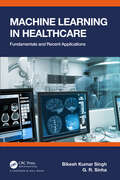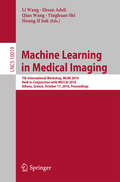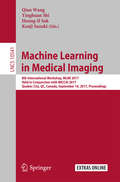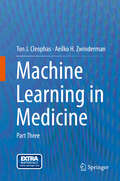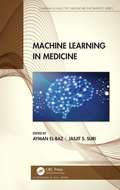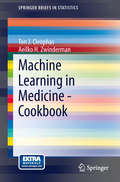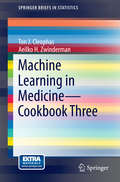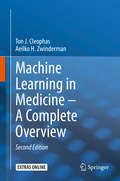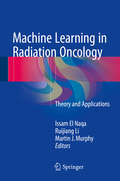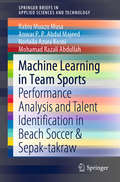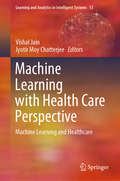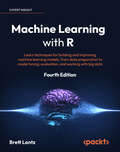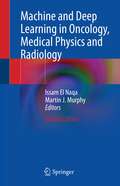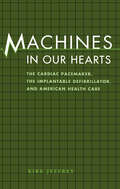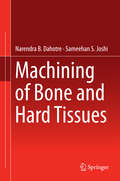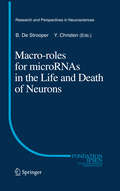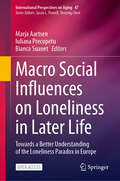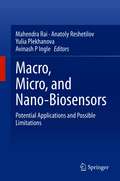- Table View
- List View
Machine Learning in Healthcare: Fundamentals and Recent Applications
by G.R. Sinha Bikesh Kumar SinghArtificial intelligence (AI) and machine learning (ML) techniques play an important role in our daily lives by enhancing predictions and decision-making for the public in several fields such as financial services, real estate business, consumer goods, social media, etc. Despite several studies that have proved the efficacy of AI/ML tools in providing improved healthcare solutions, it has not gained the trust of health-care practitioners and medical scientists. This is due to poor reporting of the technology, variability in medical data, small datasets, and lack of standard guidelines for application of AI. Therefore, the development of new AI/ML tools for various domains of medicine is an ongoing field of research. Machine Learning in Healthcare: Fundamentals and Recent Applications discusses how to build various ML algorithms and how they can be applied to improve healthcare systems. Healthcare applications of AI are innumerable: medical data analysis, early detection and diagnosis of disease, providing objective-based evidence to reduce human errors, curtailing inter- and intra-observer errors, risk identification and interventions for healthcare management, real-time health monitoring, assisting clinicians and patients for selecting appropriate medications, and evaluating drug responses. Extensive demonstrations and discussion on the various principles of machine learning and its application in healthcare is provided, along with solved examples and exercises. This text is ideal for readers interested in machine learning without any background knowledge and looking to implement machine-learning models for healthcare systems.
Machine Learning in Medical Imaging
by Qian Wang Li Wang Ehsan Adeli Yinghuan Shi Heung-Il SukThis book constitutes the refereed proceedings of the 7th International Workshop on Machine Learning in Medical Imaging, MLMI 2016, held in conjunction with MICCAI 2016, in Athens, Greece, in October 2016. The 38 full papers presented in this volume were carefully reviewed and selected from 60 submissions. The main aim of this workshop is to help advance scientific research within the broad field of machine learning in medical imaging. The workshop focuses on major trends and challenges in this area, and presents works aimed to identify new cutting-edge techniques and their use in medical imaging.
Machine Learning in Medical Imaging: 7th International Workshop, MLMI 2016, Held in Conjunction with MICCAI 2016, Athens, Greece, October 17, 2016, Proceedings (Lecture Notes in Computer Science #10019)
by Li Wang, Ehsan Adeli, Qian Wang, Yinghuan Shi and Heung-Il SukThis book constitutes the refereed proceedings of the 7th International Workshop on Machine Learning in Medical Imaging, MLMI 2016, held in conjunction with MICCAI 2016, in Athens, Greece, in October 2016. The 38 full papers presented in this volume were carefully reviewed and selected from 60 submissions. The main aim of this workshop is to help advance scientific research within the broad field of machine learning in medical imaging. The workshop focuses on major trends and challenges in this area, and presents works aimed to identify new cutting-edge techniques and their use in medical imaging.
Machine Learning in Medical Imaging: 8th International Workshop, MLMI 2017, Held in Conjunction with MICCAI 2017, Quebec City, QC, Canada, September 10, 2017, Proceedings (Lecture Notes in Computer Science #10541)
by Qian Wang, Yinghuan Shi, Heung-Il Suk and Kenji SuzukiThis book constitutes the refereed proceedings of the 8th International Workshop on Machine Learning in Medical Imaging, MLMI 2017, held in conjunction with MICCAI 2017, in Quebec City, QC, Canada, in September 2017. The 44 full papers presented in this volume were carefully reviewed and selected from 63 submissions. The main aim of this workshop is to help advance scientific research within the broad field of machine learning in medical imaging. The workshop focuses on major trends and challenges in this area, and presents works aimed to identify new cutting-edge techniques and their use in medical imaging.
Machine Learning in Medical Imaging: 9th International Workshop, MLMI 2018, Held in Conjunction with MICCAI 2018, Granada, Spain, September 16, 2018, Proceedings (Lecture Notes in Computer Science #11046)
by Yinghuan Shi Heung-Il Suk Mingxia LiuThis book constitutes the proceedings of the 9th International Workshop on Machine Learning in Medical Imaging, MLMI 2018, held in conjunction with MICCAI 2018 in Granada, Spain, in September 2018.The 45 papers presented in this volume were carefully reviewed and selected from 82 submissions. They focus on major trends and challenges in the area of machine learning in medical imaging and aim to identify new cutting-edge techniques and their use in medical imaging.
Machine Learning in Medicine
by Aeilko H. Zwinderman Ton J. CleophasMachine learning is a novel discipline concerned with the analysis of large and multiple variables data. It involves computationally intensive methods, like factor analysis, cluster analysis, and discriminant analysis. It is currently mainly the domain of computer scientists, and is already commonly used in social sciences, marketing research, operational research and applied sciences. It is virtually unused in clinical research. This is probably due to the traditional belief of clinicians in clinical trials where multiple variables are equally balanced by the randomization process and are not further taken into account. In contrast, modern computer data files often involve hundreds of variables like genes and other laboratory values, and computationally intensive methods are required. This book was written as a hand-hold presentation accessible to clinicians, and as a must-read publication for those new to the methods.
Machine Learning in Medicine (Chapman & Hall/CRC Healthcare Informatics Series)
by Jasjit S. Suri Ayman El-BazMachine Learning in Medicine covers the state-of-the-art techniques of machine learning and their applications in the medical field. It presents several computer-aided diagnosis (CAD) systems, which have played an important role in the diagnosis of several diseases in the past decade, e.g., cancer detection, resulting in the development of several successful systems. New developments in machine learning may make it possible in the near future to develop machines that are capable of completely performing tasks that currently cannot be completed without human aid, especially in the medical field. This book covers such machines, including convolutional neural networks (CNNs) with different activation functions for small- to medium-size biomedical datasets, detection of abnormal activities stemming from cognitive decline, thermal dose modelling for thermal ablative cancer treatments, dermatological machine learning clinical decision support systems, artificial intelligence-powered ultrasound for diagnosis, practical challenges with possible solutions for machine learning in medical imaging, epilepsy diagnosis from structural MRI, Alzheimer's disease diagnosis, classification of left ventricular hypertrophy, and intelligent medical language understanding. This book will help to advance scientific research within the broad field of machine learning in the medical field. It focuses on major trends and challenges in this area and presents work aimed at identifying new techniques and their use in biomedical analysis, including extensive references at the end of each chapter.
Machine Learning in Medicine - Cookbook
by Aeilko H. Zwinderman Ton J. CleophasThe amount of data in medical databases doubles every 20 months, and physicians are at a loss to analyze them. Also, traditional methods of data analysis have difficulty to identify outliers and patterns in big data and data with multiple exposure / outcome variables and analysis-rules for surveys and questionnaires, currently common methods of data collection, are, essentially, missing. Obviously, it is time that medical and health professionals mastered their reluctance to use machine learning and the current 100 page cookbook should be helpful to that aim. It covers in a condensed form the subjects reviewed in the 750 page three volume textbook by the same authors, entitled "Machine Learning in Medicine I-III" (ed. by Springer, Heidelberg, Germany, 2013) and was written as a hand-hold presentation and must-read publication. It was written not only to investigators and students in the fields, but also to jaded clinicians new to the methods and lacking time to read the entire textbooks. General purposes and scientific questions of the methods are only briefly mentioned, but full attention is given to the technical details. The two authors, a statistician and current president of the International Association of Biostatistics and a clinician and past-president of the American College of Angiology, provide plenty of step-by-step analyses from their own research and data files for self-assessment are available at extras. springer. com. From their experience the authors demonstrate that machine learning performs sometimes better than traditional statistics does. Machine learning may have little options for adjusting confounding and interaction, but you can add propensity scores and interaction variables to almost any machine learning method.
Machine Learning in Medicine - Cookbook Three
by Aeilko H. Zwinderman Ton J. CleophasUnique features of the book involve the following. 1. This book is the third volume of a three volume series of cookbooks entitled "Machine Learning in Medicine - Cookbooks One, Two, and Three". No other self-assessment works for the medical and health care community covering the field of machine learning have been published to date. 2. Each chapter of the book can be studied without the need to consult other chapters, and can, for the readership''s convenience, be downloaded from the internet. Self-assessment examples are available at extras. springer. com. 3. An adequate command of machine learning methodologies is a requirement for physicians and other health workers, particularly now, because the amount of medical computer data files currently doubles every 20 months, and, because, soon, it will be impossible for them to take proper data-based health decisions without the help of machine learning. 4. Given the importance of knowledge of machine learning in the medical and health care community, and the current lack of knowledge of it, the readership will consist of any physician and health worker. 5. The book was written in a simple language in order to enhance readability not only for the advanced but also for the novices. 6. The book is multipurpose, it is an introduction for ignorant, a primer for the inexperienced, and a self-assessment handbook for the advanced. 7. The book, was, particularly, written for jaded physicians and any other health care professionals lacking time to read the entire series of three textbooks. 8. Like the other two cookbooks it contains technical descriptions and self-assessment examples of 20 important computer methodologies for medical data analysis, and it, largely, skips the theoretical and mathematical background. 9. Information of theoretical and mathematical background of the methods described are displayed in a "notes" section at the end of each chapter. 10. Unlike traditional statistical methods, the machine learning methodologies are able to analyze big data including thousands of cases and hundreds of variables. 11. The medical and health care community is little aware of the multidimensional nature of current medical data files, and experimental clinical studies are not helpful to that aim either, because these studies, usually, assume that subgroup characteristics are unimportant, as long as the study is randomized. This is, of course, untrue, because any subgroup characteristic may be vital to an individual at risk. 12. To date, except for a three volume introductary series on the subject entitled "Machine Learning in Medicine Part One, Two, and Thee, 2013, Springer Heidelberg Germany" from the same authors, and the current cookbook series, no books on machine learning in medicine have been published. 13. Another unique feature of the cookbooks is that it was jointly written by two authors from different disciplines, one being a clinician/clinical pharmacologist, one being a mathematician/biostatistician. 14. The authors have also jointly been teaching at universities and institutions throughout Europe and the USA for the past 20 years. 15. The authors have managed to cover the field of medical data analysis in a nonmathematical way for the benefit of medical and health workers. 16. The authors already successfully published many statistics textbooks and self-assessment books, e. g. , the 67 chapter textbook entitled "Statistics Applied to Clinical Studies 5th Edition, 2012, Springer Heidelberg Germany" with downloads of 62,826 copies. 17. The current cookbook makes use, in addition to SPSS statistical software, of various free calculators from the internet, as well as the Konstanz Information Miner (Knime), a widely approved free machine learning package, and the free Weka Data Mining package from New Zealand. 18. The above software packages with hundreds of nodes, the basic processing units including virtually all of the statistical and data mining methods, can be used not only for data analyses, but also for appropriate data stora...
Machine Learning in Medicine - Cookbook Two
by Aeilko H. Zwinderman Ton J. CleophasThe amount of data medical databases doubles every 20 months, and physicians are at a loss to analyze them. Also, traditional data analysis has difficulty to identify outliers and patterns in big data and data with multiple exposure / outcome variables and analysis-rules for surveys and questionnaires, currently common methods of data collection, are, essentially, missing. Consequently, proper data-based health decisions will soon be impossible. Obviously, it is time that medical and health professionals mastered their reluctance to use machine learning methods and this was the main incentive for the authors to complete a series of three textbooks entitled "Machine Learning in Medicine Part One, Two and Three, Springer Heidelberg Germany, 2012-2013", describing in a nonmathematical way over sixty machine learning methodologies, as available in SPSS statistical software and other major software programs. Although well received, it came to our attention that physicians and students often lacked time to read the entire books, and requested a small book, without background information and theoretical discussions and highlighting technical details. For this reason we produced a 100 page cookbook, entitled "Machine Learning in Medicine - Cookbook One", with data examples available at extras. springer. com for self-assessment and with reference to the above textbooks for background information. Already at the completion of this cookbook we came to realize, that many essential methods were not covered. The current volume, entitled "Machine Learning in Medicine - Cookbook Two" is complementary to the first and also intended for providing a more balanced view of the field and thus, as a must-read not only for physicians and students, but also for any one involved in the process and progress of health and health care. Similarly to Machine Learning in Medicine - Cookbook One, the current work will describe stepwise analyses of over twenty machine learning methods, that are, likewise, based on the three major machine learning methodologies: Cluster methodologies (Chaps. 1-3) Linear methodologies (Chaps. 4-11) Rules methodologies (Chaps. 12-20) In extras. springer. com the data files of the examples are given, as well as XML (Extended Mark up Language), SPS (Syntax) and ZIP (compressed) files for outcome predictions in future patients. In addition to condensed versions of the methods, fully described in the above three textbooks, an introduction is given to SPSS Modeler (SPSS' data mining workbench) in the Chaps. 15, 18, 19, while improved statistical methods like various automated analyses and Monte Carlo simulation models are in the Chaps. 1, 5, 7 and 8. We should emphasize that all of the methods described have been successfully applied in practice by the authors, both of them professors in applied statistics and machine learning at the European Community College of Pharmaceutical Medicine in Lyon France. We recommend the current work not only as a training companion to investigators and students, because of plenty of step by step analyses given, but also as a brief introductory text to jaded clinicians new to the methods. For the latter purpose, background and theoretical information have been replaced with the appropriate references to the above textbooks, while single sections addressing "general purposes", "main scientific questions" and "conclusions" are given in place. Finally, we will demonstrate that modern machine learning performs sometimes better than traditional statistics does. Machine learning may have little options for adjusting confounding and interaction, but you can add propensity scores and interaction variables to almost any machine learning method.
Machine Learning in Medicine – A Complete Overview
by Aeilko H. Zwinderman Ton J. CleophasAdequate health and health care is no longer possible without proper data supervision from modern machine learning methodologies like cluster models, neural networks, and other data mining methodologies. The current book is the first publication of a complete overview of machine learning methodologies for the medical and health sector, and it was written as a training companion, and as a must-read, not only for physicians and students, but also for any one involved in the process and progress of health and health care.In this second edition the authors have removed the textual errors from the first edition. Also, the improved tables from the first edition, have been replaced with the original tables from the software programs as applied. This is, because, unlike the former, the latter were without error, and readers were better familiar with them.The main purpose of the first edition was, to provide stepwise analyses of the novel methods from data examples, but background information and clinical relevance information may have been somewhat lacking. Therefore, each chapter now contains a section entitled "Background Information".Machine learning may be more informative, and may provide better sensitivity of testing than traditional analytic methods may do. In the second edition a place has been given for the use of machine learning not only to the analysis of observational clinical data, but also to that of controlled clinical trials.Unlike the first edition, the second edition has drawings in full color providing a helpful extra dimension to the data analysis.Several machine learning methodologies not yet covered in the first edition, but increasingly important today, have been included in this updated edition, for example, negative binomial and Poisson regressions, sparse canonical analysis, Firth's bias adjusted logistic analysis, omics research, eigenvalues and eigenvectors.
Machine Learning in Protein Science: Efficient Prediction of Protein Structures and Properties
by Jinjin Li Yanqiang HanHarness the power of machine learning for quick and efficient calculations of protein structures and properties Machine Learning in Protein Science is a unique and practical reference that shows how to employ machine learning approaches for full quantum mechanical (FQM) calculations of protein structures and properties, thereby saving costly computing time and making this technology available for routine users. Machine Learning in Protein Science provides comprehensive coverage of topics including: Machine learning models and algorithms, from deep neural network (DNN) and transfer learning (TL) to hybrid unsupervised and supervised learning Protein structure predictions with AlphaFold to predict the effects of point mutations Modeling and optimization of the catalytic activity of enzymes Property calculations (energy, force field, stability, protein-protein interaction, thermostability, molecular dynamics) Protein design and large language models (LLMs) of protein systems Machine Learning in Protein Science is an essential reference on the subject for biochemists, molecular biologists, theoretical chemists, biotechnologists, and medicinal chemists, as well as students in related programs of study.
Machine Learning in Radiation Oncology
by Issam El Naqa Ruijiang Li Martin J. MurphyThis book provides a complete overview of the role of machine learning in radiation oncology and medical physics, covering basic theory, methods, and a variety of applications in medical physics and radiotherapy. An introductory section explains machine learning, reviews supervised and unsupervised learning methods, discusses performance evaluation, and summarizes potential applications in radiation oncology. Detailed individual sections are then devoted to the use of machine learning in quality assurance; computer-aided detection, including treatment planning and contouring; image-guided radiotherapy; respiratory motion management; and treatment response modeling and outcome prediction. The book will be invaluable for students and residents in medical physics and radiation oncology and will also appeal to more experienced practitioners and researchers and members of applied machine learning communities.
Machine Learning in Team Sports: Performance Analysis and Talent Identification in Beach Soccer & Sepak-takraw (SpringerBriefs in Applied Sciences and Technology)
by Mohamad Razali Abdullah Rabiu Muazu Musa Anwar P.P. Abdul Majeed Norlaila Azura KosniThis brief highlights the application of performance analysis tools in data acquisition, and various machine learning algorithms for evaluating team performance as well as talent identification in beach soccer and sepak takraw. Numerous performance indicators and human performance parameters are considered based on their relevance to each sport. The findings presented here demonstrate that the key performance indicators as well as human performance parameters can be used in the future evaluation of team performance as well as talent identification in these sports. Accordingly, they offer a valuable resource for coaches, club managers, talent identification experts, performance analysts and other relevant stakeholders involved in performance assessments.
Machine Learning with Health Care Perspective: Machine Learning and Healthcare (Learning and Analytics in Intelligent Systems #13)
by Jyotir Moy Chatterjee Vishal JainThis unique book introduces a variety of techniques designed to represent, enhance and empower multi-disciplinary and multi-institutional machine learning research in healthcare informatics. Providing a unique compendium of current and emerging machine learning paradigms for healthcare informatics, it reflects the diversity, complexity, and the depth and breadth of this multi-disciplinary area. Further, it describes techniques for applying machine learning within organizations and explains how to evaluate the efficacy, suitability, and efficiency of such applications. Featuring illustrative case studies, including how chronic disease is being redefined through patient-led data learning, the book offers a guided tour of machine learning algorithms, architecture design, and applications of learning in healthcare challenges.
Machine Learning with R: Learn techniques for building and improving machine learning models, from data preparation to model tuning, evaluation, and working with big data, 4th Edition
by Brett LantzLearn how to solve real-world data problems using machine learning and RPurchase of the print or Kindle book includes a free eBook in PDF format.Key FeaturesThe 10th Anniversary Edition of the bestselling R machine learning book, updated with 50% new content for R 4.0.0 and beyondHarness the power of R to build flexible, effective, and transparent machine learning modelsLearn quickly with this clear, hands-on guide by machine learning expert Brett LantzBook DescriptionMachine learning, at its core, is concerned with transforming data into actionable knowledge. R offers a powerful set of machine learning methods to quickly and easily gain insight from your data. Machine Learning with R, Fourth Edition, provides a hands-on, accessible, and readable guide to applying machine learning to real-world problems. Whether you are an experienced R user or new to the language, Brett Lantz teaches you everything you need to know for data pre-processing, uncovering key insights, making new predictions, and visualizing your findings. This 10th Anniversary Edition features several new chapters that reflect the progress of machine learning in the last few years and help you build your data science skills and tackle more challenging problems, including making successful machine learning models and advanced data preparation, building better learners, and making use of big data.You'll also find this classic R data science book updated to R 4.0.0 with newer and better libraries, advice on ethical and bias issues in machine learning, and an introduction to deep learning. Whether you're looking to take your first steps with R for machine learning or making sure your skills and knowledge are up to date, this is an unmissable read that will help you find powerful new insights in your data.What you will learnLearn the end-to-end process of machine learning from raw data to implementationClassify important outcomes using nearest neighbor and Bayesian methodsPredict future events using decision trees, rules, and support vector machinesForecast numeric data and estimate financial values using regression methodsModel complex processes with artificial neural networksPrepare, transform, and clean data using the tidyverseEvaluate your models and improve their performanceConnect R to SQL databases and emerging big data technologies such as Spark, Hadoop, H2O, and TensorFlowWho this book is forThis book is designed to help data scientists, actuaries, data analysts, financial analysts, social scientists, business and machine learning students, and any other practitioners who want a clear, accessible guide to machine learning with R. No R experience is required, although prior exposure to statistics and programming is helpful.
Machine Medical Ethics
by Simon Peter van Rysewyk Matthijs PontierThe essays in this book, written by researchers from both humanities and science, describe various theoretical and experimental approaches to adding medical ethics to a machine, what design features are necessary in order to achieve this, philosophical and practical questions concerning justice, rights, decision-making and responsibility in medical contexts, and accurately modeling essential physician-machine-patient relationships. In medical settings, machines are in close proximity with human beings: with patients who are in vulnerable states of health, who have disabilities of various kinds, with the very young or very old and with medical professionals. Machines in these contexts are undertaking important medical tasks that require emotional sensitivity, knowledge of medical codes, human dignity and privacy. As machine technology advances, ethical concerns become more urgent: should medical machines be programmed to follow a code of medical ethics? What theory or theories should constrain medical machine conduct? What design features are required? Should machines share responsibility with humans for the ethical consequences of medical actions? How ought clinical relationships involving machines to be modeled? Is a capacity for empathy and emotion detection necessary? What about consciousness? This collection is the first book that addresses these 21st-century concerns.
Machine Vision and Augmented Intelligence—Theory and Applications: Select Proceedings of MAI 2021 (Lecture Notes in Electrical Engineering #796)
by Manish Kumar Bajpai Koushlendra Kumar Singh George GiakosThis book comprises the proceedings of the International Conference on Machine Vision and Augmented Intelligence (MAI 2021) held at IIIT, Jabalpur, in February 2021. The conference proceedings encapsulate the best deliberations held during the conference. The diversity of participants in the event from academia, industry, and research reflects in the articles appearing in the volume. The book theme encompasses all industrial and non-industrial applications in which a combination of hardware and software provides operational guidance to devices in the execution of their functions based on the capture and processing of images. This book covers a wide range of topics such as modeling of disease transformation, epidemic forecast, COVID-19, image processing and computer vision, augmented intelligence, soft computing, deep learning, image reconstruction, artificial intelligence in healthcare, brain-computer interface, cybersecurity, and social network analysis, natural language processing, etc.
Machine Vision and Navigation
by Oleg Sergiyenko Wendy Flores-Fuentes Paolo MercorelliThis book presents a variety of perspectives on vision-based applications. These contributions are focused on optoelectronic sensors, 3D & 2D machine vision technologies, robot navigation, control schemes, motion controllers, intelligent algorithms and vision systems. The authors focus on applications of unmanned aerial vehicles, autonomous and mobile robots, industrial inspection applications and structural health monitoring. Recent advanced research in measurement and others areas where 3D & 2D machine vision and machine control play an important role, as well as surveys and reviews about vision-based applications. These topics are of interest to readers from diverse areas, including electrical, electronics and computer engineering, technologists, students and non-specialist readers.• Presents current research in image and signal sensors, methods, and 3D & 2D technologies in vision-based theories and applications; • Discusses applications such as daily use devices including robotics, detection, tracking and stereoscopic vision systems, pose estimation, avoidance of objects, control and data exchange for navigation, and aerial imagery processing; • Includes research contributions in scientific, industrial, and civil applications.
Machine and Deep Learning in Oncology, Medical Physics and Radiology
by Issam El Naqa Martin J. MurphyThis book, now in an extensively revised and updated second edition, provides a comprehensive overview of both machine learning and deep learning and their role in oncology, medical physics, and radiology. Readers will find thorough coverage of basic theory, methods, and demonstrative applications in these fields. An introductory section explains machine and deep learning, reviews learning methods, discusses performance evaluation, and examines software tools and data protection. Detailed individual sections are then devoted to the use of machine and deep learning for medical image analysis, treatment planning and delivery, and outcomes modeling and decision support. Resources for varying applications are provided in each chapter, and software code is embedded as appropriate for illustrative purposes. The book will be invaluable for students and residents in medical physics, radiology, and oncology and will also appeal to more experienced practitioners and researchers and members of applied machine learning communities.
Machines in Our Hearts: The Cardiac Pacemaker, the Implantable Defibrillator, and American Health Care
by Kirk JeffreyToday hundreds of thousands of Americans carry pacemakers and implantable cardioverter-defibrillators (ICDs) within their bodies. These battery-powered machines—small computers, in fact—deliver electricity to the heart to correct dangerous disorders of the heartbeat. But few doctors, patients, or scholars know the history of these devices or how "heart-rhythm management" evolved into a multi-billion-dollar manufacturing and service industry. Machines in Our Hearts tells the story of these two implantable medical devices. Kirk Jeffrey, a historian of science and technology, traces the development of knowledge about the human heartbeat and follows surgeons, cardiologists, and engineers as they invent and test a variety of electronic devices. Numerous small manufacturing firms jumped into pacemaker production but eventually fell by the wayside, leaving only three American companies in the business today. Jeffrey profiles pioneering heart surgeons, inventors from the realms of engineering and medical research, and business leaders who built heart-rhythm management into an industry with thousands of employees and annual revenues in the hundreds of millions. As Jeffrey shows, the pacemaker (first implanted in 1958) and the ICD (1980) embody a paradox of high-tech health care: these technologies are effective and reliable but add billions to the nation's medical bill because of the huge growth in the number of patients who depend on implanted devices to manage their heartbeats.
Machining of Bone and Hard Tissues
by Narendra Dahotre Sameehan JoshiThis book provides an in-depth review of state-of-the-art orthopaedic techniques and basic mechanical operations (drilling, boring, cutting, grinding/milling) involved in present day orthopaedic surgery. Casting a light on exploratory hybrid operations, as well as non-conventional techniques such as laser assisted operations, this book further extends the discussion to include physical aspects of the surgery in view of material (bone) and process parameters. Featuring detailed discussion of the computational modeling of forces (mechanical and thermal) involved in surgical procedures for the planning and optimization of the process/procedure and system development, this book lays the foundations for efforts towards the future development of improved orthopaedic surgery. With topics including the role of bone machining during surgical operations; the physical properties of the bone which influence the response to any machining operation, and robotic automation, this book will be a valuable and comprehensive literature source for years to come.
Macro Roles for MicroRNAs in the Life and Death of Neurons
by Bart De StrooperThe discovery of microRNAs has revealed an unexpected and spectacular additional level of fine tuning of the genome and how genes are used again and again in different combinations to generate the complexity that underlies for instance the brain. Since the initial studies performed in C.elegans, we gave gone a far way to begin to understand how microRNA pathways can have an impact on health and disease in human. Although microRNAs are abundantly expressed in the brain, relatively little is known about the multiple functions of these RNA molecules in the nervous system. Nevertheless, we know already that microRNA pathways play major roles in the proliferation, differentiation, function and maintenance of neuronal cells. Several intriguing studies have linked microRNAs as major regulators of the neuronal phenotype, and have implicated specific microRNAs in the regulation of synapse formation and plasticity. Dysfunction of microRNA pathways is also slowly emerging as a potential important contributor to the pathogenesis of major neurodegenerative disorders such as Alzheimer's disease and Parkinson's disease. These novel insights appear to be particular promising for the understanding of the very frequent and badly understood sporadic forms of these diseases as compared to the genetic forms. Thus, the better understanding of the implications of this novel field of molecular biology is crucial for the broad area of neurosciences, from the fundamental aspects to the clinic, and from novel diagnostic to potentially therapeutic applications for severe neurological and maybe psychiatric diseases.
Macro Social Influences on Loneliness in Later Life: Towards a Better Understanding of the Loneliness Paradox in Europe (International Perspectives on Aging #47)
by Marja Aartsen Iuliana Precupetu Bianca SuanetThis open access book explores the macro-social influences on loneliness in later life, emphasizing how societal structures, cultural contexts, and broader social transformations shape the experience of loneliness. Dedicated to the social construction of loneliness and the notable heterogeneity in its prevalence across European countries, this volume brings together a distinguished selection of experts who share their latest insights on meso- and macro-level influences, cultural and structural theories, and the impact of digitalization, climate change, and societal crises. Divided into five parts, the book addresses key aspects of this complex issue. The first part introduces the central themes, outlining the relevance of loneliness as a societal concern and discussing the limitations of existing research, which predominantly focuses on individual-level factors. It highlights the need for a multi-level approach that incorporates micro, meso, and macro perspectives to fully understand the contextual influences on loneliness. The second part delves into theoretical perspectives, offering a comprehensive framework for understanding loneliness at different levels. It examines the interplay between individual, relational, and societal factors while also exploring cultural and social exclusion perspectives that shed light on how loneliness manifests across different contexts. The third part presents empirical evidence, focusing on variations in loneliness across different social groups and regions in Europe. It synthesizes research on micro- and meso-level determinants while also providing a review of macro-level influences. This part highlights the role of welfare regimes, demographic trends, and broader societal conditions in shaping the prevalence and experience of loneliness. The fourth part explores recent societal developments that may influence loneliness, including digitalization, migration, climate change, and societal crises. These emerging topics illustrate how macro-level transformations can either alleviate or exacerbate loneliness, depending on how they interact with existing social structures and individual circumstances. The final part discusses methodological advancements and policy implications. It introduces an innovative approach to analyzing macro-social influences on loneliness and revisits the &‘loneliness paradox&’ in light of new findings. The book concludes with policy recommendations and future research directions, emphasizing the need for a holistic approach that integrates individual, relational, and societal dimensions to develop more effective interventions against loneliness. In sum, by adopting a macro-social lens, this book contributes to a deeper understanding of the societal, cultural, and policy-related determinants of loneliness. It offers a foundation for evidence-based interventions that go beyond individual-level solutions, recognizing loneliness as a socially embedded phenomenon shaped by broader societal forces. It is our hope and expectation that the book and its content will fundamentally change our understanding of loneliness and strategies to combat it.
Macro, Micro, and Nano-Biosensors: Potential Applications and Possible Limitations
by Mahendra Rai Avinash P. Ingle Anatoly Reshetilov Yulia PlekhanovaThis book includes an international group of researchers who present the latest achievements in the field of enzyme, immune system, and microbial and nano-biosensors. It highlights the experimental evidence for formation of biological fuel cells (BFCs)-which has a dual purpose – as a device that produces electricity and the systems which produce it simultaneously cleaning up the environment from polluting organic compounds. Considering the work in the field of macro, micro and nano-biosensors, considerable attention is paid to the use of nanomaterials for the modification of working electrodes. Nanomaterials in some cases can significantly improve the parameters of analytical systems. Readers will be interested in the projection of the presented theoretical and experimental materials in the field of practical application of modern analytical developments. The presented results in many cases imply the possibility of using the created models of macro, micro and nano-biosensors, and biofuel elements in the field of health, and protection/restoration of the environment. It includes information about all existing types of transducers of signals in biosensors – electrochemical, optical and quantum-optics, thermoelectric, data of atomic force microscopy, piezoelectric, and more. On the basis of these principles, descriptions are given about the functioning of macro, micro and nano- biosensors for the detection of compounds used in medicine, detection of compounds that clog the environment, and thus affect human health, for compounds that are potentially the basis for the production of drugs, for the selection of compounds that have medicinal activity, for immunodetection, and to assess the quality of food. These questions form the basis of research carried out in the field of biosensors in the world. Since the described models of biosensors have high sensitivity, high measurement speed and selectivity, the described results attract the attention of both the ordinary reader and business class specialists who create and implement analytical technologies. This book is very useful for researchers in life sciences, chemical sciences, physics, and engineering. In addition, it will be useful for the persons working in industry. Advanced technologies specialists will be attracted by the novelty of the proposed solutions and their relevance and ease of implementation. Since the studies contain sections describing the parameters of different biosensors, BFCs, they are easily navigated into assessing the effectiveness of the practical use of the proposed device. The relevant sections indicate such characteristics as detection ranges, life span, type of biological material used, the method of formation of the bio-receptor part. These parameters are of interest to both developers of new models of biosensors and BFC, and their manufacturers.
